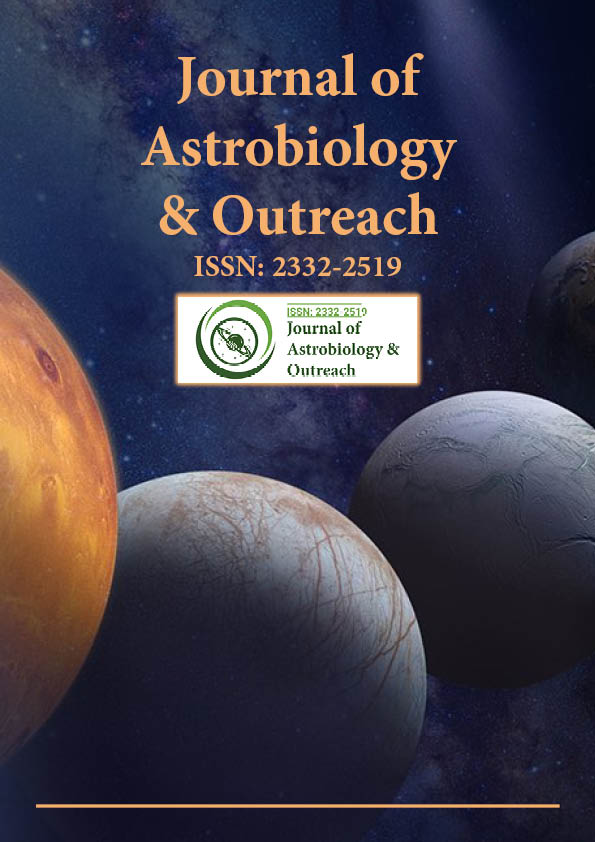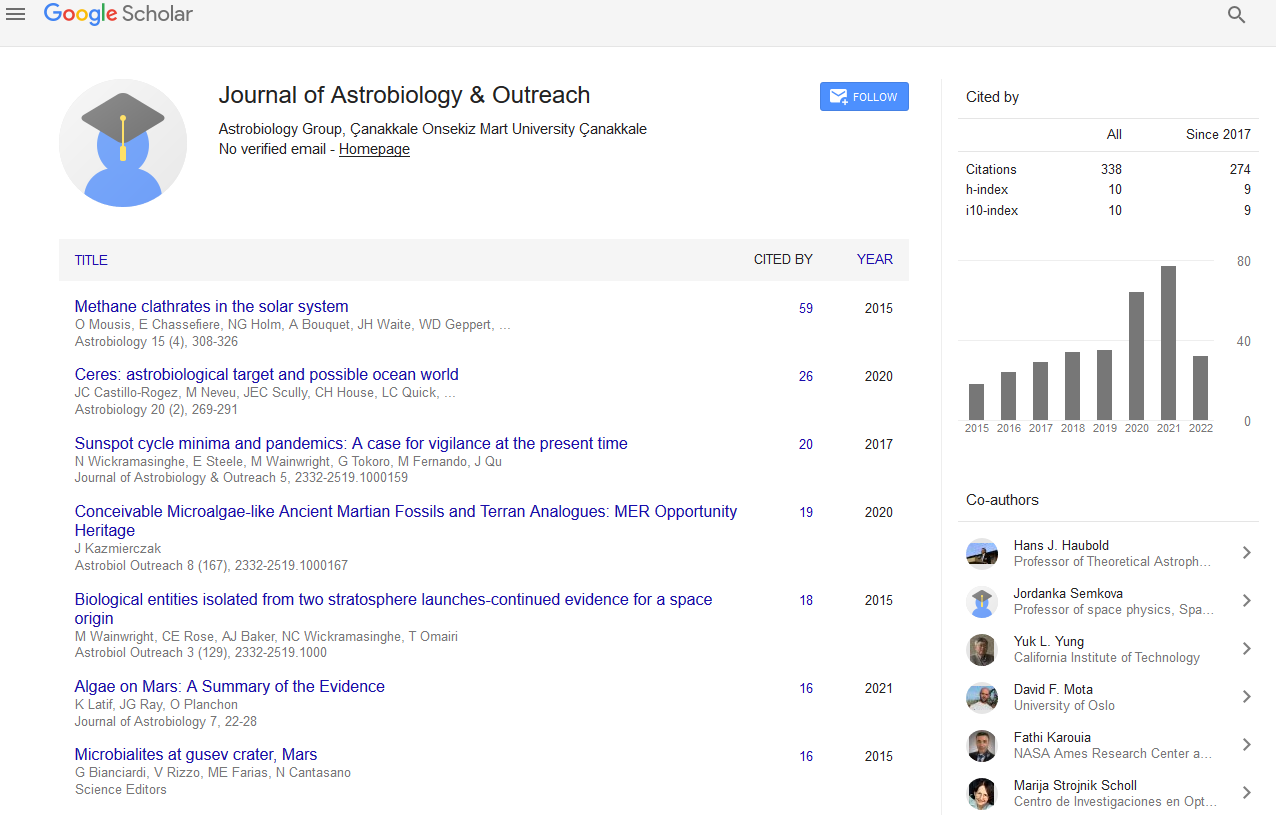Indexed In
- Open J Gate
- Academic Keys
- JournalTOCs
- RefSeek
- Hamdard University
- EBSCO A-Z
- OCLC- WorldCat
- Google Scholar
Useful Links
Share This Page
Journal Flyer

Open Access Journals
- Agri and Aquaculture
- Biochemistry
- Bioinformatics & Systems Biology
- Business & Management
- Chemistry
- Clinical Sciences
- Engineering
- Food & Nutrition
- General Science
- Genetics & Molecular Biology
- Immunology & Microbiology
- Medical Sciences
- Neuroscience & Psychology
- Nursing & Health Care
- Pharmaceutical Sciences
Short Communication - (2025) Volume 13, Issue 1
Scientific and Technical Priorities in Astrobiological Exploration
Henry Quinn*Received: 19-Feb-2025, Manuscript No. JAO-25-28773; Editor assigned: 21-Feb-2025, Pre QC No. JAO-25-28773 (PQ); Reviewed: 07-Mar-2025, QC No. JAO-25-28773; Revised: 14-Mar-2025, Manuscript No. JAO-25-28773 (R); Published: 21-Mar-2025, DOI: 10.35248/2332-2519.25.13.374
Description
The search for extraterrestrial life remains one of the most compelling scientific pursuits in modern planetary exploration. Missions targeting Mars and other celestial bodies in the solar system increasingly focus on identifying biosignatures indicators of present or past life [1]. As such, a comparative analysis of lifedetection methods is significant to guide instrumentation and strategy for future missions. Various techniques, both direct and indirect, are currently employed or under development to detect potential signs of life, ranging from in situ chemical assays to remote sensing technologies and sample return missions [2]. Each method presents unique advantages and limitations based on environmental conditions, target biomarkers, sensitivity and feasibility.
On Mars, missions such as Viking, Curiosity and Perseverance have depended heavily on in situ chemical and mineralogical analysis [3]. Instruments like the Sample Analysis at Mars (SAM) suite onboard Curiosity and the SHERLOC instrument on Perseverance are designed to detect organic compounds and characterize past habitability. These tools provide high-resolution molecular and isotopic data, allowing for detection of organics, volatiles and possible metabolic by-products. However, despite their sensitivity, results are often limited by planetary contamination, surface radiation and the ambiguity in distinguishing abiotic from biotic sources [4].
In comparison, spectroscopic remote sensing methods using orbiters or flybys provide broader spatial coverage [5]. For example, CRISM on the Mars Reconnaissance Orbiter has revealed hydrated minerals and ancient lakebeds, pointing to past habitable environments. While unable to directly detect life, such methods are essential for identifying promising regions for follow-up investigations. Similar instruments are proposed for missions to Europa and Enceladus, where subsurface oceans might harbor microbial life. These approaches emphasize geophysical and geochemical indicators over direct biological detection.
Another potential method is the use of immunoassays and microfluidic lab-on-a-chip technologies, which mimic Earthbased biomedical diagnostics. The sign of life detector instrument, for example, employs antibody arrays to bind and detect specific biomolecules such as proteins and polysaccharides. These methods provide the specificity and sensitivity required for low-abundance biomarkers, though they depend on assumptions of biochemical similarity to terrestrial life. Cross-reactivity and degradation of biological targets in extreme planetary environments remain concerns [6].
In contrast, techniques based on microscopy and imaging, including atomic force microscopy and fluorescence microscopy, attempt to identify morphological evidence of microbial structures or biofilms. While these provide visual validation of microfossil-like features, they are highly susceptible to interpretation bias. A fundamental challenge is distinguishing true biological morphology from abiotic mineral shapes, especially in samples subjected to billions of years of diagenesis or erosion [7].
Mass spectrometry, particularly with high-resolution time-of-flight and orbitrap configurations, plays a critical role across multiple detection methods. It enables the analysis of complex organic molecules, isotope ratios and potential lipid biomarkers. The upcoming ExoMars Rosalind Franklin rover, for example, includes the Mars organic molecule analyzer instrument, which integrates laser desorption and gas chromatography-mass spectrometry [8]. These sophisticated tools potential deeper molecular insights but also demand significant onboard power and careful contamination control.
Sample return missions, such as NASA’s Mars Sample Return campaign, represent a change towards by enabling Earth-based analysis with state-of-the-art laboratory tools unavailable for spacecraft miniaturization [9]. Techniques such as synchrotron radiation, nanoSIMS and next-generation sequencing (if applicable) provide unmatched resolution and interpretative power. However, these missions are logistically complex, costly and vulnerable to time delays and the risk of sample degradation during return.
For icy moons like Europa and Enceladus, cryobot and plume sampling technologies are being explored [10]. Instruments designed to capture ejected water vapor or melt through subsurface ice provide potential access to environments protected from surface radiation. Technologies under development include Raman spectroscopy and nanopore-based biosensors customized for low-temperature aqueous systems. These efforts face challenges such as sample preservation, instrument sterilization and the unknown composition of extraterrestrial oceans.
Ultimately, the most effective life-detection strategies will likely involve hybrid systems that combine multiple detection modalities. This integrative approach increases the reliability of results, cross-validates findings and addresses the limitations of individual techniques. For example, coupling spectroscopic analysis with immunoassays and mass spectrometry can improve confidence in the detection of genuine biosignatures.
In conclusion, the comparative study of life-detection techniques highlights the need for mission-specific strategies informed by target environment, scientific goals and technical constraints. While no single method guarantees unambiguous detection of extraterrestrial life, the synergy among diverse technologies significantly enhances our capacity to answer one of humanity’s most important questions. Future missions must prioritize both scientific rigor and flexibility, integrating the lessons learned from Mars exploration with emerging innovations suited for the broader solar system.
References
- Enya K, Yamagishi A, Kobayashi K, Yoshimura Y. Comparative study of methods for detecting extraterrestrial life in exploration mission of Mars and the solar system. Life Sci Space Res (Amst). 2022;34:53-67.
[Crossref] [Google Scholar] [PubMed]
- Bogue R. Remote chemical sensing: A review of techniques and recent developments. Sensor Rev. 2018;38(4):453-7.
- Falkovich AH, Ganor E, Levin Z, Formenti P, Rudich Y. Chemical and mineralogical analysis of individual mineral dust particles. J Geophys Res Atmos. 2001;106(D16):18029-36.
- Pirich R, Weir J, Leyble D, DiGiuseppe M. The effects of ionizing radiation, temperature, and space contamination effects on photonic coatings. Nanophotonics and Macrophotonics for Space Environments III. 2009;7467:27-35.
- Clark RN, Roush TL. Reflectance spectroscopy: Quantitative analysis techniques for remote sensing applications. J Geophys Res Solid Earth. 1984;89(B7):6329-40.
- Merino N, Aronson HS, Bojanova DP, Feyhl-Buska J, Wong ML, Zhang S, et al. Living at the extremes: Extremophiles and the limits of life in a planetary context. Front Microbiol. 2019;10:780.
- Cuéllar-Cruz M. Influence of abiotic factors in the chemical origin of life: Biomorphs as a study model. ACS omega. 2021;6(13):8754-63.
- Fawdon P, Orgel C, Adeli S, Balme M, Calef FJ, Davis JM, et al. The high-resolution map of Oxia Planum, Mars; the landing site of the ExoMars Rosalind Franklin rover mission. J Maps. 2024;20(1):2302361.
- Mattingly R, May L. Mars sample return as a campaign. In2011 Aerospace Conference 2011 Mar 5 (pp. 1-13). IEEE.
- McKay CP. An approach to searching for life on Mars, Europa, and Enceladus. Space Sci Rev. 2008;135:49-54.
Citation: Quinn H (2025). Scientific and Technical Priorities in Astrobiological Exploration. J Astrobiol Outreach. 13:374.
Copyright: © 2025 Quinn H. This is an open-access article distributed under the terms of the Creative Commons Attribution License, which permits unrestricted use, distribution, and reproduction in any medium, provided the original author and source are credited.

